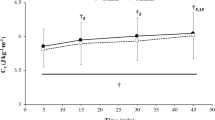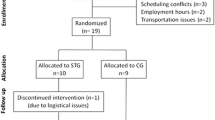Abstract
This study aimed to examine the effects of a 5-h hilly run on ankle plantar (PF) and dorsal flexor (DF) force and fatigability. It was hypothesised that DF fatigue/fatigability would be greater than PF fatigue/fatigability. Eight male trail long distance runners (42.5 ± 5.9 years) were tested for ankle PF and DF maximal voluntary isokinetic contraction strength and fatigue resistance tests (percent decrement score), maximal voluntary and electrically evoked isometric contraction strength before and after the run. Maximal EMG root mean square (RMSmax) and mean power frequency (MPF) values of the tibialis anterior (TA), gastrocnemius lateralis (GL) and soleus (SOL) EMG activity were calculated. The peak torque of the potentiated high- and low-frequency doublets and the ratio of paired stimulation peak torques at 10 Hz over 100 Hz (Db10:100) were analysed for PF. Maximal voluntary isometric contraction strength of PF decreased from pre- to post-run (−17.0 ± 6.2%; P < 0.05), but no significant decrease was evident for DF (−7.9 ± 6.2%). Maximal voluntary isokinetic contraction strength and fatigue resistance remained unchanged for both PF and DF. RMSmax SOL during maximal voluntary isometric contraction and RMSmax TA during maximal voluntary isokinetic contraction were decreased (P < 0.05) after the run. For MPF, a significant decrease for TA (P < 0.05) was found and the ratio Db10:100 decreased for PF (−6.5 ± 6.0%; P < 0.05). In conclusion, significant isometric strength loss was only detected for PF after a 5-h hilly run and was partly due to low-frequency fatigue. This study contradicted the hypothesis that neuromuscular alterations due to prolonged hilly running are predominant for DF.




Similar content being viewed by others
References
Beischer AD, Beamond BM, Jowett AJ, O’Sullivan R (2009) Distal tendinosis of the tibialis anterior tendon. Foot Ankle Int 30(11):1053–1059
Bigland-Ritchie B, Johansson R, Lippold OC, Woods JJ (1983) Contractile speed and EMG changes during fatigue of sustained maximal voluntary contractions. J Neurophysiol 50(1):313–324
Bishop GW, Fallon KE (1999) Musculoskeletal injuries in a six-day track race: ultramarathoner’s ankle. Clin J Sport Med 9(4):216–220
Bosquet L, Maquet D, Forthomme B, Nowak N, Lehance C, Croisier JL (2010) Effect of the lengthening of the protocol on the reliability of muscle fatigue indicators. Int J Sports Med 31(2):82–88
Buczek FL, Cavanagh PR (1990) Stance phase knee and ankle kinematics and kinetics during level and downhill running. Med Sci Sports Exerc 22(5):669–677
Christina KA, White SC, Gilchrist LA (2001) Effect of localized muscle fatigue on vertical ground reaction forces and ankle joint motion during running. Hum Mov Sci 20(3):257–276
Corona BT, Balog EM, Doyle JA, Rupp JC, Luke RC, Ingalls CP (2010) Junctophilin damage contributes to early strength deficits and EC coupling failure after eccentric contractions. Am J Physiol Cell Physiol 298(2):365–376
Costill DL, Jansson E, Gollnick PD, Saltin B (1974) Glycogen utilization in leg muscles of men during level and uphill running. Acta Physiol Scand 91(4):475–481
Dvir Z (2004) Isokinetics: muscle testing, interpretation, and clinical applications, 2nd edn. Churchill Livingstone, Tel-Aviv
Fallon KE (1996) Musculoskeletal injuries in the ultramarathon: the 1990 Westfield Sydney to Melbourne run. Br J Sports Med 30(4):319–323
Finni T, Kyrolainen H, Avela J, Komi PV (2003) Maximal but not submaximal performance is reduced by constant-speed 10-km run. J Sports Med Phys Fitness 43(4):411–417
Gottschall JS, Kram R (2005) Ground reaction forces during downhill and uphill running. J Biomech 38(3):445–452
Hermens HJ, Freriks B, Disselhorst-Klug C, Rau G (2000) Development of recommendations for SEMG sensors and sensor placement procedures. J Electromyogr Kinesiol 10(5):361–374
Kennedy A, Hug F, Bilodeau M, Sveistrup H, Guevel A (2011) Neuromuscular fatigue induced by alternating isometric contractions of the ankle plantar and dorsiflexors. J Electromyogr Kinesiol 21(3):471–477
Kobayashi H, Sakurai M, Kobayashi T (2007) Extensor digitorum longus tenosynovitis caused by talar head impingement in an ultramarathon runner: a case report. J Orthop Surg (Hong Kong) 15(2):245–247
Kufel TJ, Pineda LA, Mador MJ (2002) Comparison of potentiated and unpotentiated twitches as an index of muscle fatigue. Muscle Nerve 25:438–444
Levenez M, Kotzamanidis C, Carpentier A, Duchateau J (2005) Spinal reflexes and coactivation of ankle muscles during a submaximal fatiguing contraction. J Appl Physiol 99(3):1182–1188
Martin V, Millet GY, Lattier G, Perrod L (2004a) Effects of recovery modes after knee extensor muscles eccentric contractions. Med Sci Sports Exerc 36(11):1907–1915
Martin V, Millet GY, Martin A, Deley G, Lattier G (2004b) Assessment of low-frequency fatigue with two methods of electrical stimulation. J Appl Physiol 97(5):1923–1929
Martin V, Millet GY, Lattier G, Perrod L (2005) Why does knee extensor muscles torque decrease after eccentric-type exercise? J Sports Med Phys Fitness 45(2):143–151
Martin V, Kerherve H, Messonnier LA, Banfi JC, Geyssant A, Bonnefoy R, Feasson L, Millet GY (2009) Central and peripheral contributions to neuromuscular fatigue induced by a 24-h treadmill run. J Appl Physiol 108(5):1224–1233
Millet GY (2011) Can neuromuscular fatigue explain running strategies and performance in ultra-marathons? The flush model. Sports Med 41(6):489–506
Millet GY, Lepers R, Maffiuletti NA, Babault N, Martin V, Lattier G (2002) Alterations of neuromuscular function after an ultramarathon. J Appl Physiol 92(2):486–492
Mizrahi J, Verbitsky O, Isakov E (2000a) Fatigue-related loading imbalance on the shank in running: a possible factor in stress fractures. Ann Biomed Eng 28(4):463–469
Mizrahi J, Verbitsky O, Isakov E (2000b) Shock accelerations and attenuation in downhill and level running. Clin Biomech (Bristol, Avon) 15(1):15–20
Mizrahi J, Verbitsky O, Isakov E (2001) Fatigue-induced changes in decline running. Clin Biomech (Bristol, Avon) 16(3):207–212
Patikas D, Michailidis C, Bassa H, Kotzamanidis C, Tokmakidis S, Alexiou S, Koceja DM (2002) Electromyographic changes of agonist and antagonist calf muscles during maximum isometric induced fatigue. Int J Sports Med 23(4):285–289
Place N, Lepers R, Deley G, Millet GY (2004) Time course of neuromuscular alterations during a prolonged running exercise. Med Sci Sports Exerc 36(8):1347–1356
Reber L, Perry J, Pink M (1993) Muscular control of the ankle in running. Am J Sports Med 21(6):805–810
Ross EZ, Middleton N, Shave R, George K, Nowicky A (2007) Corticomotor excitability contributes to neuromuscular fatigue following marathon running in man. Exp Physiol 92(2):417–426
Salavati M, Moghadam M, Ebrahimi I, Arab AM (2007) Changes in postural stability with fatigue of lower extremity frontal and sagittal plane movers. Gait Posture 26(2):214–218
Saldanha A, Nordlund Ekblom MM, Thorstensson A (2008) Central fatigue affects plantar flexor strength after prolonged running. Scand J Med Sci Sports 18(3):383–388
Swanson SC, Caldwell GE (2000) An integrated biomechanical analysis of high speed incline and level treadmill running. Med Sci Sports Exerc 32(6):1146–1155
van Gent RN, Siem D, van Middelkoop M, van Os AG, Bierma-Zeinstra SM, Koes BW (2007) Incidence and determinants of lower extremity running injuries in long distance runners: a systematic review. Br J Sports Med 41(8):469–480
Verges S, Maffiuletti NA, Kerherve H, Decorte N, Wuyam B, Millet GY (2009) Comparison of electrical and magnetic stimulations to assess quadriceps muscle function. J Appl Physiol 106(2):701–710
Acknowledgments
The authors wish to thank Mr Corentin Chalençon for the analysis of the EMG data and Dr Amanda Johnson for the English revision of the manuscript.
Conflict of interest
We affirm that we have no financial affiliation (including research funding) or involvement with any commercial organisation that has a direct financial interest in any matter included in this manuscript.
Author information
Authors and Affiliations
Corresponding author
Additional information
Communicated by Jean-René Lacour.
Rights and permissions
About this article
Cite this article
Fourchet, F., Millet, G.P., Tomazin, K. et al. Effects of a 5-h hilly running on ankle plantar and dorsal flexor force and fatigability. Eur J Appl Physiol 112, 2645–2652 (2012). https://doi.org/10.1007/s00421-011-2220-9
Received:
Accepted:
Published:
Issue Date:
DOI: https://doi.org/10.1007/s00421-011-2220-9




